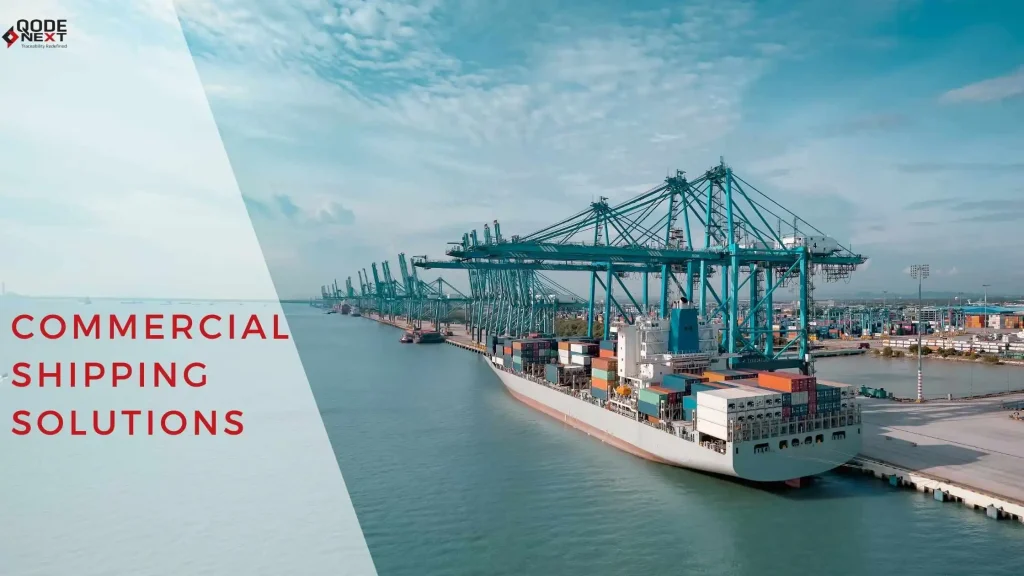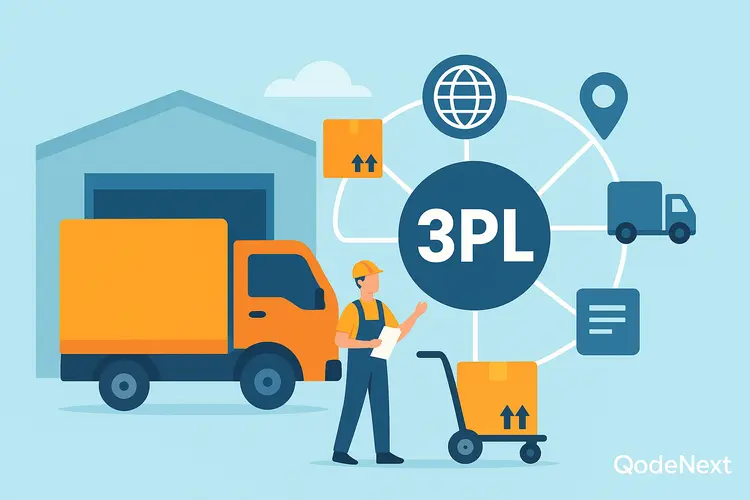The growing demand for goods in global markets has driven retail and wholesale organizations to embrace eCommerce channels. This shift has spurred a significant need for distribution centers and streamlined supply chain operations. Commercial shipping plays a pivotal role in this ecosystem.
According to Statista, the Indian logistics market was valued at USD 250 billion in 2021 and is projected to reach USD 380 billion by 2025. As a result, investing in the innovation, design, and technology of commercial shipping has become more critical than ever.
This guide delves into the essentials of commercial shipping, explaining its operations, advantages, and other key details to help businesses and sellers make informed decisions for their local and global ventures.

Defining Commercial Shipping
Commercial shipping methods are commonly preferred for international transportation. Additionally, businesses rely on commercial shipping for ordering bulk cargo or replenishing stock. One key advantage is the opportunity to benefit from substantial discounts, as large volumes of goods are shipped in a single consignment.
Incorporating non-domestic transportation into business operations fosters stronger relationships with trade partners and customers. Regular shipments typically include strong record-keeping systems that improve operational efficiency. This ensures smooth, timely deliveries, reduces product damage, and streamlines payment processes.
Commercial Shipping: How Does it Work?
Commercial shipping follows a simple process. After your products are ready, a commercial shipper picks them up from the warehouse. The shipment is then delivered to the customer’s loading dock, making it easier to send large amounts of goods. When it arrives, a clerk checks the shipment and confirms the delivery.
This method is an efficient transportation solution for businesses, as handling larger volumes often reduces the cost per unit. Commercial shipping is more cost-effective than regional shipping and typically involves large containers to maximize efficiency.
The way a business manages its shipping operations after a sale significantly impacts future orders. For instance, damaged goods or delayed deliveries can leave customers with a negative impression, potentially harming the business’s reputation—even if the issues were beyond its control.
Selecting a reliable partner is crucial for ensuring smooth operations. Maintaining a strong relationship with transporters helps uphold your business’s credibility.
Commercial Shipping Vs Residential Shipping
There are 3 key differences between these two that every business owner should be aware of. Let’s dive deeper into these distinctions and how you can prepare for each.
Delivery Address
The primary difference between both is the destination address. B2B shipments are directed to business addresses, while residential deliveries are sent to home addresses.
However, if a retailer uses their home address as their business address, shipments to that location would technically fall under business shipping. This is common among new brand owners who are in the early stages of setting up their supply chain operations and don’t yet place large orders from third-party suppliers.
Shipping Costs
Many entrepreneurs know that B2B typically costs more than residential delivery. Business addresses, such as warehouses and distribution centers in business parks, enable shippers to use cost-effective methods like LTL or LCL shipping. These options allow shippers to combine goods from various companies into a single trailer, optimizing costs.
In contrast, residential shipping involves smaller trucks that can navigate densely populated areas, which means more trips are needed, and the efficiency of large-scale shipping is lost.
Since business addresses are often in low-density areas with wider roads, carriers can make fewer trips, thus reducing their costs. As a result, carriers charge residential surcharges for home or home-business deliveries, typically between $4 – $5, depending on the service.
Delivery Duration
Shipping and delivery might be confusing at times, but there’s a significant difference between the two. In B2B shipping, the priority is on delivering large quantities of goods in perfect condition at the lowest cost, meaning longer delivery times.
For example, international sea freight shipments can take anywhere from 20 to 40 days, while air cargo can arrive in just 1-3 days, and rail deliveries typically take up to a week.
On the other hand, residential shipping tends to be faster.
Ecommerce orders and domestic deliveries typically arrive within 3-5 days unless customers opt for expedited transporting. For time-sensitive orders, next-day or same-day delivery is often available. Additionally, domestic consigning offers a variety of flexible delivery options, including slot-based and curbside delivery.
Benefits of a Commercial Shipping Provider
For many eCommerce businesses, partnering with a form of transportation such as a commercial company is a reliable, cost-effective, and efficient way to keep products moving and boost profits. Even if you feel your business isn’t large enough to warrant a shipping partner, doing so can actually help accelerate sales and foster growth.
Such providers take care of order fulfillment from start to finish. Their expertise means more and more B2B companies trust them to handle the shipping process. By working with a commercial shipper, you’ll enjoy several advantages, such as:
- Consolidating all your shipping costs into one predictable monthly bill.
- Negotiating better rates with a 3PL provider for more affordable shipping.
- Reducing your capital investment by outsourcing warehousing, packaging, and logistics.
- Gaining the flexibility to handle peak times, such as the holiday season or periods of business growth.
- Freeing up your time and that of your team to focus on marketing, innovation, and other important tasks.
- Getting storage space for large orders.
- Ensuring your products are safe during transit and arrive in great condition.
- Saving money as commercial shippers often consolidate deliveries within business districts, saving on fuel and time.
- Staying updated on the latest shipping rates and global regulations.
Because of these benefits, non-domestic transportation has a bright future ahead with various trends to watch out for in 2024.
5 Best Practices for Commercial Shipping
When deciding on the best commercial shipping practices, there are several key factors to consider:
1. Offer Free Shipping
Customers love free shipping as it feels like a saving. However, ensure it’s sustainable for your business. You can absorb shipping costs by adjusting your pricing or offering free shipping on orders over a certain amount, benefiting both you and your customers.
2. Focus on Careful Product Preparation
First impressions matter. Ensure your products are packaged securely to arrive safely. Customers appreciate attention to detail, even before they open the box.
3. Automate Your Processes
Look for automation opportunities to reduce costs and keep things running smoothly. Check what Warehouse Management Software (WMS) the shipper uses and inquire about automation in the picking, packing, and labeling processes. These shortcuts can speed up deliveries and help streamline operations.
4. Maintain Quality Control
Never ship outdated or damaged products, even at discounted rates. Every item you send should meet your high standards for quality. If you’re outsourcing shipping, ensure your provider has adequate space to store your products. It’s also essential to check with your 3PL ahead of peak sales periods to ensure they can manage the increased volume.
5. Follow Up with Customers
Keep communication open after orders are placed. Provide tracking information, answer questions about shipping, and address any concerns about delays. If you’re using a 3PL provider, they will handle contact services on your behalf, ensuring a smooth experience for your clients.
FAQ: The Ultimate Guide to Commercial Shipping
How long is commercial shipping?
The duration depends on the method and distance. Domestic shipments can take 1-7 days, while international freight, like sea shipments, can take anywhere from 20 to 40 days.
What are the limitations of commercial shipping?
It might be slower, especially for large shipments. It may also have limited flexibility in delivery times, higher costs for international shipments, and restrictions on certain types of goods or locations.
Is commercial shipping better than retail shipping?
It is more cost-effective for bulk shipments and businesses but can be slower and less flexible. Retail shipping offers faster, more flexible options but is often more expensive for large quantities.
Conclusion
Commercial shipping is essential for businesses looking to optimize cost-effective and efficient logistics, especially for bulk shipments. While it offers great advantages, such as scalability and reliability, partnering with a trusted provider like Qodenext can streamline your operations, ensuring smooth and timely deliveries for your growing business.






